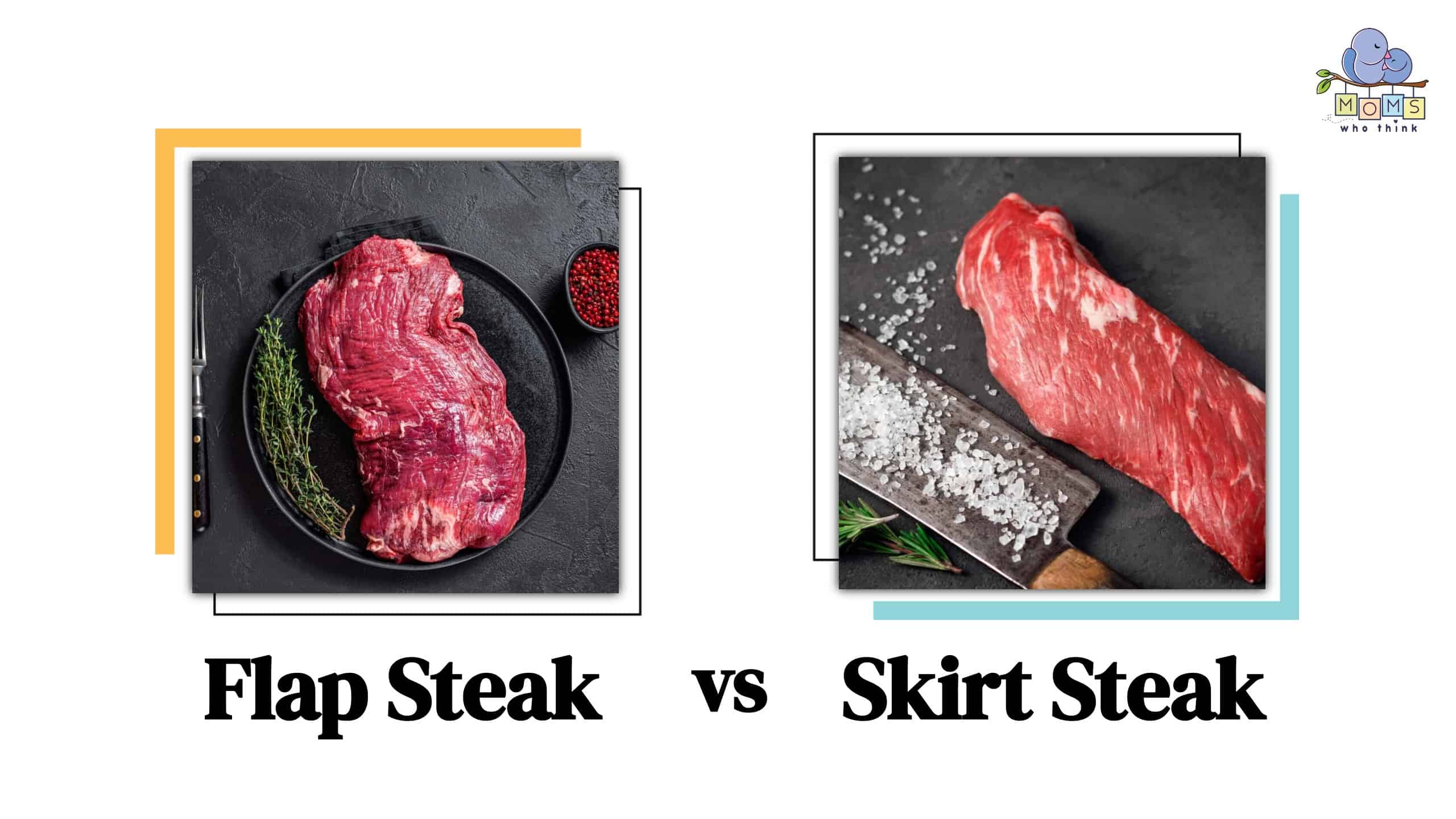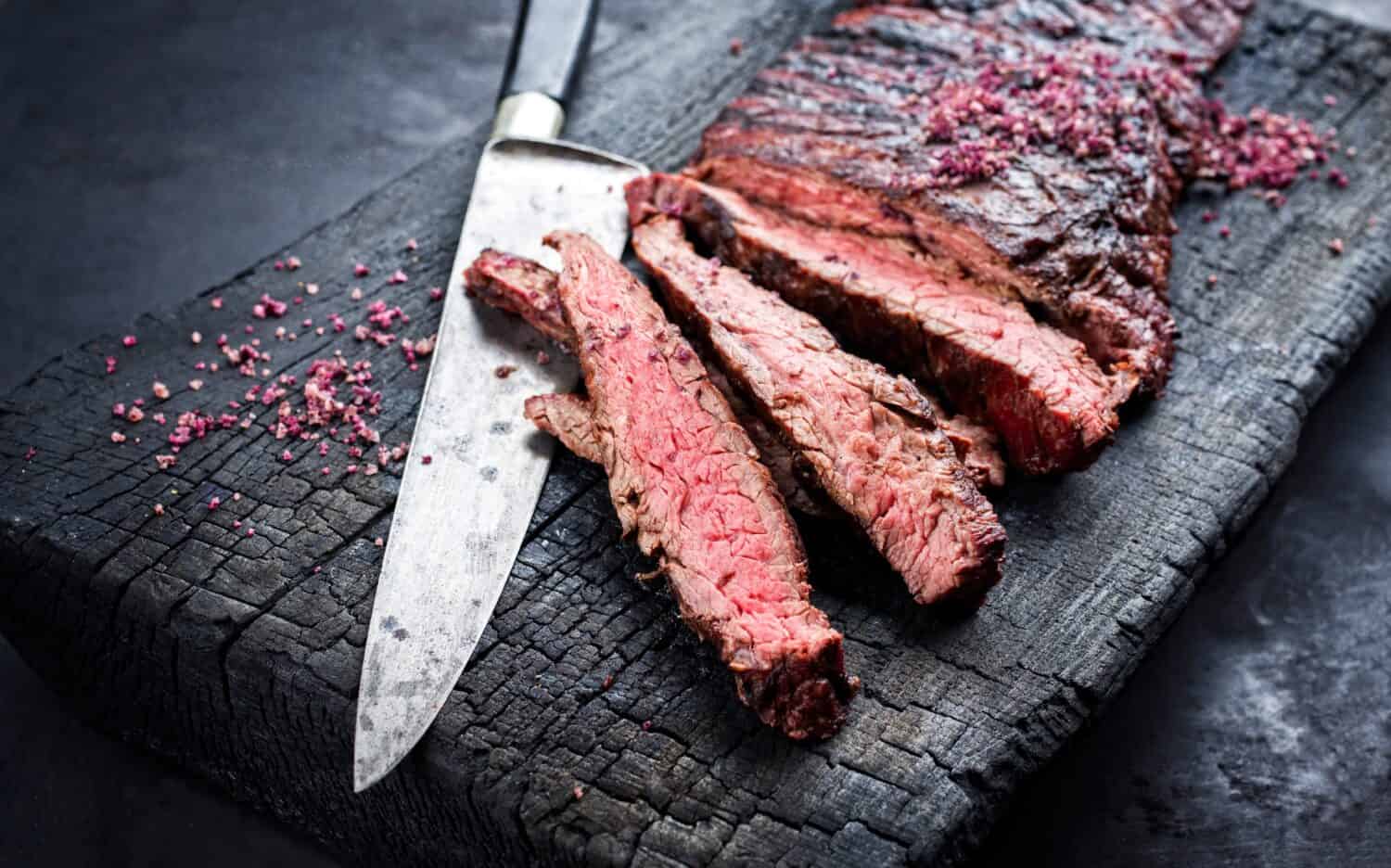Introduction

When it comes to choosing the perfect steak for your next cookout or family dinner, it’s important to understand the differences between flank steak and flat iron steak. These two cuts of meat offer distinct characteristics in terms of flavor, texture, and cooking methods. Flank steak is known for its lean composition and versatility, while flat iron steak boasts a tender and juicy texture due to its marbling fat. By understanding the unique qualities of each cut, you can make an informed decision based on your personal preferences and cooking style. In this article, we will explore the differences between flank and flat iron steak, helping you choose the champion steak for your next meal.
Introduction To Flank Vs Flat Iron Steak
When it comes to choosing the perfect steak for your next meal, understanding the differences between flank steak and flat iron steak is crucial. Flank steak is known for its lean composition and versatility, making it a popular choice for those seeking a healthier option. On the other hand, flat iron steak offers a tender and juicy texture due to its marbling fat, resulting in a rich and flavorful eating experience. Whether you prefer a leaner cut or enjoy the succulent tenderness of marbled meat, knowing the distinctions between flank and flat iron steak will help you make an informed decision for your next culinary adventure.
Flank Steak
Flank steak is a lean and versatile cut of beef that is known for its rich flavor and slightly tougher texture. It is taken from the abdominal muscles of the cow and is characterized by its long, flat shape. Flank steak is best cooked quickly over high heat, making it perfect for grilling or stir-frying. To enhance its tenderness, it is recommended to marinate flank steak before cooking. This allows the flavors to penetrate the meat and helps to break down its connective tissues. When properly cooked and sliced against the grain, flank steak offers a delicious and satisfying dining experience.
Flank Steak: Characteristics And Cooking Methods

Flank steak is a lean and versatile cut of beef known for its rich flavor and slightly tougher texture. It is taken from the abdominal muscles of the cow and has a long, flat shape. Flank steak is best cooked quickly over high heat, making it perfect for grilling or stir-frying. Marinating the steak before cooking enhances its tenderness and allows flavors to penetrate the meat. Slicing flank steak against the grain creates more tender pieces. Its versatility makes it a great choice for dishes like fajitas, stir-fries, or as a filling for tacos or sandwiches.
Flank Steak: Tips For Marinating And Grilling
To maximize the tenderness and flavor of flank steak, it is recommended to marinate it before grilling. Here are some tips for marinating and grilling flank steak:
- Marinating: Marinate the flank steak for at least 2 hours or overnight to tenderize the meat. Use a marinade containing acidic ingredients like citrus juice or vinegar, along with herbs, spices, and oil. The acid helps break down the muscle fibers and infuse the meat with flavor.
- Score the meat: Before marinating, score the surface of the flank steak with shallow diagonal cuts. This allows the marinade to penetrate deeper, resulting in more flavorful and tender meat.
- Preheat the grill: Preheat your grill to high heat (around 450-500°F) to ensure a nice sear on the meat.
- Cook to medium-rare: Flank steak is best cooked to medium-rare for optimal tenderness. Grill the steak for about 4-6 minutes per side, depending on the thickness, until it reaches an internal temperature of 130-135°F.
- Let it rest: After grilling, let the flank steak rest for 5-10 minutes before slicing. This allows the juices to redistribute and keeps the meat moist.
Remember to slice the flank steak against the grain, which helps break up the muscle fibers and ensures a more tender bite. Serve the grilled flank steak as a main dish or use it as a filling for tacos, fajitas, or sandwiches. Enjoy the delicious flavors of a perfectly grilled flank steak!
Flat Iron Steak
Flat Iron Steak is a popular cut of beef known for its tenderness and rich flavor. It is taken from the shoulder area of the cow and is often referred to as a “butcher’s cut” due to its unique shape. This steak is well-marbled, with fat running through the meat, which adds to its flavor and juiciness. Flat Iron Steak can be cooked using various methods such as grilling, pan-searing, or broiling. It is important to cook the steak to medium-rare or medium to preserve its tenderness and avoid overcooking. This versatile cut is perfect for steak lovers looking for a flavorful and tender dining experience.
Flat Iron Steak: Overview And Cooking Techniques

Flat Iron Steak is a popular cut of beef known for its tenderness and rich flavor. It is taken from the shoulder area of the cow and is often referred to as a “butcher’s cut” due to its unique shape. This steak is well-marbled, with fat running through the meat, which adds to its flavor and juiciness. Flat Iron Steak can be cooked using various methods such as grilling, pan-searing, or broiling. It is important to cook the steak to medium-rare or medium to preserve its tenderness and avoid overcooking. This versatile cut is perfect for steak lovers looking for a flavorful and tender dining experience.
Flat Iron Steak: Seasoning And Cooking Tips
When it comes to seasoning and cooking a Flat Iron Steak, simplicity is key. Start by seasoning the steak generously with kosher salt and freshly ground black pepper. For an extra kick of flavor, you can also add herbs and spices like garlic powder, onion powder, or paprika. Let the steak sit at room temperature for about 30 minutes before cooking to ensure even cooking.
To cook the Flat Iron Steak, the best method is to either grill or pan-sear it. Heat your grill or skillet over high heat and cook the steak for about 4-6 minutes per side for medium-rare, or adjust the cooking time based on your desired level of doneness. Remember to let the steak rest for a few minutes before slicing to allow the juices to redistribute and create a tender and juicy result. Enjoy your perfectly cooked Flat Iron Steak!
Flavor And Texture Comparison
When comparing the flavor and texture of Flank and Flat Iron steak, there are noticeable differences. Flank steak has a stronger, more pronounced beefy flavor, while the Flat Iron steak is known for its tenderness and marbling, resulting in a richer taste.
In terms of texture, Flank steak tends to be larger and thicker, with a slightly tougher texture that can be tenderized through proper marinating and cooking techniques. In contrast, the Flat Iron steak is more tender and melt-in-your-mouth, making it a popular choice for steak lovers.
Overall, the choice between Flank and Flat Iron steak depends on personal preference for flavor and texture.
Comparison Of Flavor Profiles And Textures Of Flank And Flat Iron Steak

When it comes to flavor and texture, there are noticeable differences between Flank and Flat Iron steak. Flank steak is known for its strong, pronounced beefy flavor, while Flat Iron steak is praised for its tenderness and rich taste. Flank steak tends to be larger and thicker, with a slightly tougher texture that can be tenderized through marinating and proper cooking techniques. On the other hand, Flat Iron steak is more tender and melts in your mouth. Ultimately, the choice between the two depends on personal preference for flavor and texture.
The Versatility Of Flank And Flat Iron Steak In Different Recipes
Flank and Flat Iron steaks are incredibly versatile when it comes to cooking them in various recipes. Flank steak’s robust flavor pairs well with bold marinades and spices, making it ideal for Asian stir-fries, Mexican fajitas, or even as the star ingredient in a delicious steak salad. On the other hand, the tenderness and rich taste of Flat Iron steak make it perfect for grilling, pan-searing, or even broiling. It can be served as a standalone steak or sliced thinly for sandwiches, steak tacos, or steak sandwiches. The possibilities are endless when it comes to using these cuts in different culinary creations.
Nutritional Value
Flank and flat iron steak both offer a significant amount of protein, making them a great choice for those looking to meet their daily protein needs. A 3-ounce serving of flank steak contains approximately 162 calories and 24 grams of protein. On the other hand, a similar portion of flat iron steak provides around 250 calories and 28 grams of protein. Both cuts are relatively lean and low in fat, making them a healthier option compared to fattier cuts of beef. Additionally, flank steak contains essential nutrients such as iron and zinc, while flat iron steak is a good source of B vitamins.
Nutritional Benefits Of Flank And Flat Iron Steak

Both flank and flat iron steak provide a range of nutritional benefits. They are both excellent sources of protein, which is essential for muscle growth and repair. In addition, flank steak contains important nutrients such as iron and zinc, which play a role in immune function and energy production. Flat iron steak, on the other hand, is rich in B vitamins, including niacin, vitamin B6, and vitamin B12, which are important for brain health and nerve function. Both cuts are relatively lean and low in fat, making them a healthy choice for those looking to maintain a balanced diet.
Comparison Of Calories, Protein, And Fat Content
Both flank and flat iron steak are relatively lean cuts of meat, making them a healthy option for those watching their calorie intake. On average, a 4-ounce serving of flank steak contains about 220 calories, while the same portion of flat iron steak contains around 280 calories. When it comes to protein, both cuts provide a significant amount. Flank steak typically contains around 27 grams of protein per serving, while flat iron steak offers slightly more at 31 grams. In terms of fat content, both cuts are relatively low, with flank steak containing around 10 grams of fat and flat iron steak containing about 12 grams per serving. Overall, both cuts provide a good balance of protein and fat while being moderate in calories.
Conclusion
In conclusion, when it comes to choosing between flank and flat iron steak, both options have their own unique qualities and culinary uses. Flank steak offers a lean and beefy flavor, making it ideal for marinating and grilling. On the other hand, flat iron steak provides a tender and juicy texture, perfect for various cooking techniques like pan-searing or broiling. Ultimately, the choice between the two cuts depends on personal preference and the specific dish you intend to prepare. Regardless of your selection, both flank and flat iron steak are delicious and nutritious options for meat lovers.
Factors To Consider When Choosing Between Flank And Flat Iron Steak

When deciding between Flank and Flat Iron Steak, there are several factors to consider. Firstly, consider the flavor and texture preferences you have for your steak. If you prefer a lean and beefy flavor, then Flank Steak is a good choice. On the other hand, if you desire a tender and juicy texture, go for Flat Iron Steak. Additionally, think about the cooking methods you plan to use. Flank Steak is great for marinating and grilling, while Flat Iron Steak is versatile and can be cooked through various techniques like pan-searing or broiling. Consider these factors to make the best choice for your culinary needs.
Summing Up The Differences And Versatility Of Each Cut
In summary, the differences between Flank and Flat Iron Steak lie in their origin, flavor, and tenderness. Flank Steak is known for its lean and beefy flavor, while Flat Iron Steak offers a more tender and juicy texture. In terms of versatility, Flank Steak is great for marinating and grilling, making it perfect for flavorful dishes. Flat Iron Steak, on the other hand, can be cooked through various techniques like pan-searing or broiling, allowing for a wide range of culinary possibilities. Consider your preferences and cooking methods to choose the ideal cut for your next steak dish.
Frequently Asked Questions: Flank vs. Flat Iron Steak
1. What is the difference between flank steak and flat iron steak?
Flank steak and flat iron steak are two popular cuts of beef that come from different parts of the cow. Flank steak comes from the abdominal region of the cow, while flat iron steak is cut from the shoulder area, specifically from the top blade muscle.
2. Which cut is more tender?
When it comes to tenderness, flat iron steak is considered to be more tender than flank steak. Flat iron steak has a good marbling of fat and is cut from a less exercised muscle, resulting in a more tender texture. Flank steak, on the other hand, is known for its flavor but requires proper cooking techniques to ensure tenderness.
3. How do I cook flank steak and flat iron steak?
Both cuts of steak are best cooked quickly over high heat, such as grilling, broiling, or pan-searing. Flank steak should be cooked to medium-rare or medium doneness to ensure it remains juicy and tender. Flat iron steak can be cooked to medium or medium-rare to enjoy its tenderness and robust flavor.
4. Can flank and flat iron steak be used interchangeably in recipes?
While flank steak and flat iron steak can be used in similar recipes, it is important to note that they have different textures and flavors. Flat iron steak works well in recipes where the tenderness of the meat is essential, such as stir-fries or fajitas. Flank steak is often marinated to enhance its flavor and is great for dishes like tacos, London broil, or Korean bulgogi.
5. Are there any specific cooking methods or tips for each cut?
For flank steak, it is crucial to slice it against the grain to ensure tenderness. This means cutting across the muscle fibers rather than parallel to them. Additionally, allowing flank steak to rest after cooking and slicing it thinly can also help improve its tenderness. As for flat iron steak, it is important not to overcook it, as it can become tough. Cook it to medium or medium-rare, and let it rest before slicing.
6. How do I know which cut to choose?
The choice between flank steak and flat iron steak ultimately depends on personal preference and the desired outcome of the dish. If tenderness is your priority, then flat iron steak is the way to go. However, if you prefer bold, beefy flavors and are willing to put in a little extra effort to ensure tenderness, then flank steak might be a better fit.
7. How should flank and flat iron steaks be stored?
Both cuts should be stored in the refrigerator to maintain freshness. It is best to keep them wrapped tightly in plastic wrap or butcher paper and stored in airtight containers or resealable plastic bags. They can be stored for up to three to four days in the refrigerator.
8. Can flank and flat iron steaks be frozen?
Yes, if you want to store flank or flat iron steak for an extended period, you can freeze them. Make sure to wrap them tightly in plastic wrap or aluminum foil and place them in a freezer bag or airtight container. They can be kept in the freezer for up to three to four months. When ready to use, thaw them in the refrigerator before cooking.
In summary, while both flank steak and flat iron steak are delicious cuts of beef, they differ in tenderness, flavor, and ideal cooking methods. Understanding their unique characteristics enables you to choose the most suitable cut for your culinary needs.

Kemah Cafe is a family-owned eatery that takes pride in offering a delightful array of Vietnamese, Chinese, and Thai dishes. Located at the heart of the community, Kemah Cafe has been serving up delicious Pho and other authentic Asian cuisine for many years. Founded with a passion for sharing the flavors of the East, Kemah Cafe has become a beloved culinary destination for locals and visitors alike. The warm and welcoming atmosphere of the cafe, combined with the tantalizing aromas of freshly prepared dishes, creates an unforgettable dining experience.